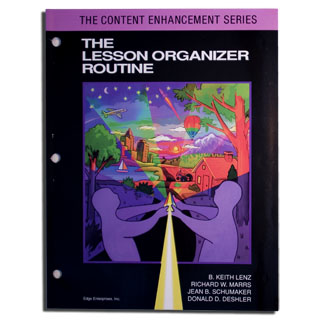Description
Research on the Paired Associates Strategy
Overview
The Paired Associates Strategy is used by students to study information in subject-area courses to prepare for tests. This study investigated the effects of instruction in the Paired Associates Strategy on high-school students’ performance with regard to learning pairs or trios of facts. (For example, the information that Barak Obama became president of the United States in January of 2009 comprises a trio of facts.) This strategy initially involves the creation of one of four types of mnemonic devices, including making mental images, relating the information to prior knowledge, using key words, and making a code. Then the student creates a study card and tests him/herself over the information. Twelve students with LD participated in the multiple-baseline across-students designs, with three students participating in each iteration of the design. The regularly assigned resource room teacher provided the instruction.
Two types of tests were given for the repeated measures. In the first type of test (called “Controlled Tests”), students were given a list of 20 pairs or trios of facts and asked to learn them. Each type of mnemonic device the students learned could be used to remember five of the pairs or trios in the list. The students were given 45 minutes to study the information. On the next day, they were given a fill-in-the-blank test over the information.
In the second type of test (called “Content Tests”), the students were given a written passage, similar to a passage that they would encounter in a high school textbook and in which 20 pairs or trios of factual items had been embedded. The students were asked to study the information in the passage, make study cards, and take a test over the information on the next day.
Results
Before instruction, the 12 students earned an average score of 18% correct on the Controlled Tests and 22% correct on the Content Tests. The students learned the strategy quickly, meeting the mastery criterion on creating each type of mnemonic device within one or two trials. After instruction, the students’ mean score on the Controlled Tests was 85% and on the Content Tests was 76%. With the exception of one score, all the students’ scores during baseline represented failing performances. After instruction, 59 of the 66 test scores represented passing performances. In the maintenance condition, ten of the 12 students maintained their posttest performance levels on follow-up tests. Two students received additional instruction after their maintenance performance levels did not match posttest levels. These two students met their posttest performance levels in the maintenance condition.
Conclusions
This study showed that high school students with LD could learn a complex memory strategy for studying for tests. Their grades improved on tests that were similar to tests that they might encounter in required general education courses.
References
Bulgren, J. A., Hock, M. F., Schumaker, J. B., Deshler, D. D. (1995). The effects of instruction in a paired associates strategy on the information mastery performance of students with learning disabilities. Learning Disabilities Research and Practice, 10(1), 22-37.
About the Author

Janis Bulgren, Ph.D.
Affliations
Associate Research Scientist
University of Kansas Center for Research on Learning
Courtesy Assistant Professor
Department of Special Education
University of Kansas
My Background and Interests
The focus of my research has been developing ways to help adolescents, including those with disabilities, succeed in inclusive general education classes. Having two degrees in English and teaching at the high school level for several years made me very aware of the needs of both teachers and students in diverse subject-area classes. This led to me to pursue a degree in special education from the University of Kansas. My combined background of general education and special education has allowed me to pursue my interests and insights about how teachers teach and how students learn. As a result, I have been privileged to work with teachers in a variety of subject areas and to do research on instructional techniques that support all students, including those who are low achieving, average achieving, and high achieving, as well as students with disabilities.
My focus has been on a programmatic line of research that builds upon a foundation of knowledge of factual information to create an understanding of critical concepts, to enable manipulation of information including making comparisons, analyzing causes and effects, weighing options to make decisions, and using reasoning to analyze claims and arguments. The goal of the instructional practices that my colleagues and I have designed is to guide students as they engage in deep learning and comprehension across subject-area domains and ultimately in the generalization of thinking to subject-area and real-world issues.
The Story Behind the Paired Associates Strategy
As I worked on developing new ways of teaching, I realized that more and more emphasis is being put on deep comprehension demands in our schools and the real world. I learned that deep comprehension begins with a base of facts and concepts. Then, these facts and concepts are organized and used to manipulate relationships. Finally, these understandings are used to solve real-world problems. Therefore, I came to understand that the learning of facts and concepts is never an end in itself. It is a springboard to deep comprehension and application of understandings.
I brought this understanding to the task of developing a way to help students learn facts. In addition, before the development of and research on the instructional package for teaching the Paired Associates Strategy, I had previously worked with teachers as they planned to teach students approaches to acquiring conceptual knowledge with the Concept Mastery Routine. During this process, I began to think about the scope of knowledge students need to be able to learn concepts. Research tells us that a good factual foundation is needed in order for students to acquire and use concepts. This understanding helped our research team to conduct research on how to help students recall important information with the Paired Associates Strategy. We learned that mnemonic devices could support student learning of factual information as a basis for deep comprehension and application of information.
The Paired Associates Strategy was needed to ensure that students could recall factual information. Four different ways of learning information were incorporated into this strategy: (1) forming mental images; (2) making familiar associations; (3) developing keyword and peg- word mnemonic devices; and (4) translating numbers to an alphabetic code.
My Thoughts About Paired Associates Instruction
The development of four ways to help students learn important information clarified my understandings that less is more — that is, if there are a variety of ways to achieve a goal, then we should start with the easiest.
Many strategies require several layers of elaboration to ensure learning. However, by sequencing the four Paired Associates strategies from easiest to the more complex, the goal was to help students become more efficient learners. As a result, the four strategies begin with those requiring less elaboration, layers of memory, mnemonic devices, and strategic steps.
Therefore, the first strategy, which requires visual imagery, simply requires putting two pictures together, that is to “Create a picture.” The second also requires that picture — with an added layer of finding something familiar for the picture, that is, students have to “Relate to something familiar.”
The third, the “peg word” or key word strategy, requires identifying key syllables to facilitate recall. This requires more elaboration and would be chosen in preference to one of the first two only when absolutely necessary due to the added layers of cognitive requirements involved in isolating syllables as well as creating pictures.
Finally, the last strategy, which involves coding, is even more elaborate because it requires transformation of numbers to letters and creating mnemonic devices. However, these latter strategies are, indeed, needed at times, and available for use. Judicious choice of the most appropriate strategy is paramount to efficient and effective recall strategies.
Teacher Feedback on the Paired Associates Strategy
Feedback from teachers who participated in our field test indicated that they had a new appreciation for how they themselves learned, how their diverse student population learned, and how one size does not fit all students or all types of information to be remembered. Students clearly need options among which they can choose to facilitate their learning of factual information, and this strategy provides them with those options.
Contact Information
Please contact me through Edge Enterprises, Inc. (877-767-1487).







